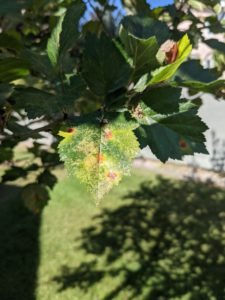This disease of hawthorns and juniper shrubs is becoming more common. The disease requires two hosts to complete its life cycle (Juniper and Hawthorn). The symptoms look very different in the two host species.

Key Points
- Minor infestations may look objectionable but cause little damage to the Hawthorn tree
- Chemical controls may be possible using a specific product in a window in the spring
Tree Damage
Rust spots appear on the leaves of the Hawthorn trees in the late Spring/early Summer and the fruiting bodies that look like little hairs can be seen on the underside of leaves and later in the year on the fruit. Spores can infect the branches of a juniper host. Galls on Juniper start off with bright orange color and look like Jello, they harden in the summer and turn brown in color. The following Spring the galls produce spores that are dispersed by wind to other hawthorn trees, and the disease cycle continues. A very similar disease affects cedars and apple trees (Cedar/Apple Rust). The damage to Hawthorn Trees is considered aesthetic as there is not a lot of damage caused to the tree.
Control Measures
- It is recommended to clean up the fallen leaves from infected hawthorns in the fall to prevent any spores from the leaves transferring back to the trees in the Spring.
- The fungus requires two hosts to complete its life cycle so removing one of the hosts from your yard may help alleviate the issue depending on the proximity of susceptible trees on neighbouring properties.
- Remove galls from affected Juniper shrubs by pruning in the dormant (Winter) season when the disease is not active and cannot be spread.
- Avoid planting Juniper and Hawthorn together in the Landscape.
- The only chemical control would include preventative spraying with copper based fungicide in early Spring and continuing once a week until early Summer. This type of spray is only beneficial in a preventative situation.


